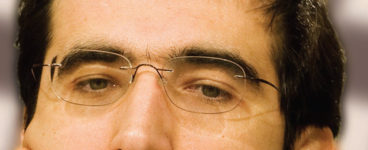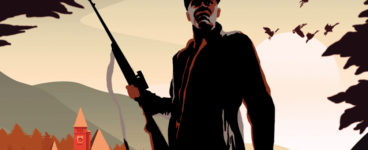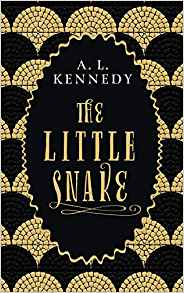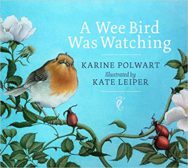‘Any sensible and observant visitor would then see that they were in a friendly city filled with good things and happiness.’
We’re big fans of small gift hardbacks here at BooksfromScotland, and fans of AL Kennedy too, so her latest release, The Little Snake, is definitely on our Christmas list. Here, Laura Waddell discovers its message of hope, trust and kindness.
The Little Snake
By AL Kennedy
Published by Canongate Books
Just in time for Christmas comes a short fable wrapped in gold. The cover of The Little Snake by AL Kennedy shines with the scales of snake Lanmo.
Google tells me this word means ‘death’ in Haition Creole. The reader doesn’t have to know this to appreciate the solid two-syllable name, rare and befitting an unusual creature, but simple enough for a child to grasp. But although the snake slips away periodically, on lengthy missions tasked with delivering fatal bites to an array of deserving humans at the end of their lives, at the core of this story is a warm heart. An unlikely friendship forms between this mysterious, cold-blooded snake and a little girl called Mary, on whose lips the name seesaws.
Mary lives in a town once prosperous where locals charmingly flew red kites above the chimneytops. Details are simple enough to avoid tweeness, but we get the gist. The collective has degraded and the future is uncertain. Change has happened in a short enough space of time to be within her own short living memory. Mary has a small garden on the roof of her parents’ building, across which she takes tiny steps so as to make a short walk feel long and satisfying. It’s the perspective of a child who has very little, using her imagination to make humble things vast. Although the town struggles to procure food, there grows a rose and simple vegetables. The family eat, resourcefully and good-natured, until the time comes when self-determination alone cannot make up for societal ill fortune.
Lanmo the snake is witnessed only by Mary when he arrives at her home one day. Small, and self-conscious of this, he is prone to boasting and unwittingly funny. Despite Lanmo’s deathly habits he chooses not to eat Mary, and the two become friends, cuddling up together for confidences and naps. Things become strained only when he tries to eat Mary’s kitten, but he spits it out again. The kitten sneezes with a “meoof”, grooms its fur back into shape, and all is well. When Lanmo is away from Mary, he sends her good dreams; Mary counts his long absences to the day.
As things become worse, Mary’s family leaves, and a boy from school she has taken a liking to tags along. Lanmo discovers a note she has left behind and makes his way to her, finding Mary and the boy in the woods, sleeping in trees for protection. Others from the town have dispersed, too, and Mary’s parents left the two to continue without them, with the implication they were not up to continuing the journey. Lanmo offers to wed the pair, with the logic that the word of a golden snake can be no less official than registered celebrants. For rings, he gives up two golden scales to Mary, who plucks them from his body; they mould fluidly around fingers. This is sacrifice: love hurts. But not so much physically for Lanmo losing scales as the knowledge that Mary is travelling to an adult realm, and he will make fewer appearances in her life. The married pair travel on to a new town with the help of the snake’s guidance; it appears over a hill as a beacon of safety and prosperity, and there they live their lives. They’re happy, but the magic of a speaking snake is something left in childhood.
Being a fable, The Little Snake is filled with symbols infused with magic and meaning. Golden rings, good dreams, a difficult journey, and a speaking creature are the backdrop to a subtle battle between good and evil. Mary, pure of heart, loves the snake easily, and tries to teach him what she knows of the emotion. It’s Lanmo’s journey, perhaps, that takes the hardest road. He already has a moral compass; those he takes out with his fangs include an exploitative industrialist, a blink-and-you’ll-miss-it clue as to why Mary’s impoverished home declined while others prospered, hinting at Capitalist inequality. But the warmth of love, and acting in its interest, is new and difficult for him. Mary has never doubted the little snake; she has firm expectations for his capacity to love, and perhaps it is this faith which has made it possible.
Deceptively simple, as fables are, there are parallels with the real world in the themes of displaced peoples, arduous migration, and loneliness. Reading it, I thought of Irmgard Keun’s Child of All Nations, a story narrated by a child which describes crossing Europe in the late 1930s to seek safety from rising ethno-nationalism. The Little Snake is subtler and the lesson we learn from it, that love and friendship lead the way to a safe and happy society, is more optimistic, but perhaps no less true for that. A child’s perspective, after all, can observe what adults can and will not.
Adult and child readers alike will leave with a fondness of this little snake who appears, scales glinting, as a symbol of hope when it is needed most, hoping that was a shimmer of gold they glimpsed from the corner of their eye.
The Little Snake by AL Kennedy is published by Canongate Books, priced £9.99
Another Christmas recommendation: A Wee Bird Was Watching by Karine Polwart, illustrated by Kate Lieper, published by BC Books, priced £6.99
ALSO IN THIS ISSUE

 Vladimir Kramnik: The Inside Story of a Chess Genius
Vladimir Kramnik: The Inside Story of a Chess Genius
‘Vladimir’s style is linked to enjoying the game. He likes to play beautiful chess.’

 Local Hero: Richard Hannay Returns!
Local Hero: Richard Hannay Returns!
‘Whatever had brought him to Scotland, it was clearly a secret venture unsanctioned by conventional …














